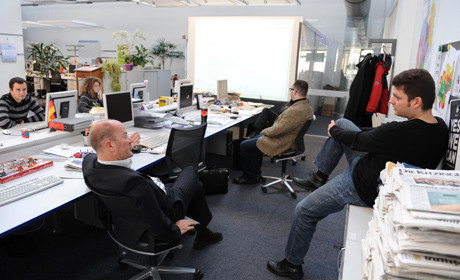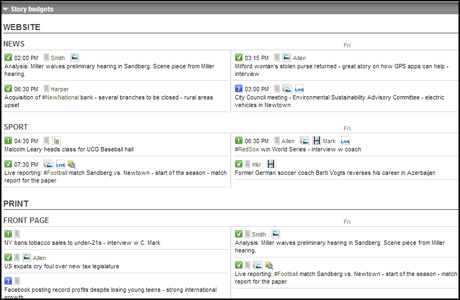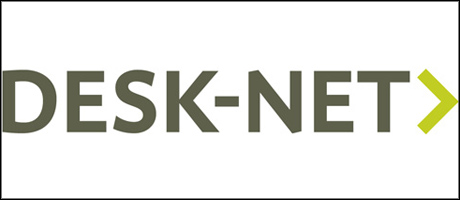
Newsroom meeting at regional publisher Mediengruppe Oberfranken with Desk-Net displayed on projector
Credit: By Ronald Rinklef/MGOMost newsrooms need to publish across an ever-increasing number of publication platforms.
And the economic situation forces them to reduce the amount of time they spend on unnecessary processes so that they can focus on core editorial tasks.
In this three-part series we look at how modern newsrooms coordinate their staff and how they handle the management of editorial appointments.
We start out, though, with a look at how to improve the quality and efficiency of a newsroom’s story planning.
All of these ideas have been developed by journalists using the editorial management tool Desk-Net.
Remarkably, the core ideas on how to improve a newsroom’s story planning processes are very similar, even though they work for a variety of newsrooms ranging from local to national media companies and non-traditional publishers such as Red Bull Media House.
Implement simple yet effective story planning guidelines
The basic advice for high-quality story planning across multiple platforms is don’t overdo it.
You can probably think of dozens of data points that could be written down as part of a structured planning process. And you can come up with very detailed processes for when to do what, by whom.
Experience has shown, however, that you should keep it rather simple.
Following three simple guidelines will get you off to a good start:
- Enter all your story ideas into a joint electronic list so that there is shared knowledge. No more separate notes, Word documents, etc.
- Enter them early - not just a minute before the next newsroom meeting.
- Write them down in an understandable manner. Think about what the actual story is. Don’t just put in a few generic keywords like “city council meeting”.
If it is just an idea several weeks in advance of its first possible publication date just writing it down and linking it with a desk usually does the job.

Story budgets in Desk-Net
In later stages you should
- assign it to one or more publication platforms (e.g. online and print),
- define the publication date (and time) and
- assign reporters, photographers etc. to it.
Modern tools allow you to easily import emails (e.g. press conference invitations) and data from news agencies or event databases in order to reduce the amount of manual work.
Story budgets - sort and filter them as you need them

Example of story budget consisting of two stories planned for two platforms
Having all stories and story ideas in one central system provides you with four crucial views:
- Platform view: What’s the story budget per publication platform on any given day or even at any given time?
- Desk view: What are the stories of a particular desk on any given day - regardless of the platform they will be published on?
- Story view: When and on what platforms will a specific story be published?
- Personal view: What are my assignments and until when do I have to deliver?
Establishing a central repository for all stories that can be accessed by anyone according to his access rights significantly reduces the amount of unnecessary information processes in your newsroom.
Wasting too much time in newsroom meetings?
The other major area for improvement is newsroom meetings. Some of them may even be rendered unnecessary once you have an editorial management tool.
Typically, however, they are used in a more productive and quality-enhancing way once such a tool has been introduced.
Many of Desk-Net’s clients use some simple guidelines for better meetings:
- Everyone participating in the meeting screens the story budget prior to the meeting. There is no time wasted in the meeting telling everyone else what a desk plans to write about. Also, some story budgets are huge. If the editorial management tool provides such a feature the participants can filter the budget and just check the top stories as marked by the different desks.
- The meeting is used to move stories from the Proposal status to the Accepted status.
- Most importantly a streamlined newsroom meeting offers more time to discuss those stories that require or benefit from a discussion..
- In most cases changes to the story budget or assignments are made right in the system during the meeting rendering additional emails or phone calls after meeting unnecessary. Reporters are automatically informed about all relevant changes to their assignments.
Communicate efficiently with production desks
In newsrooms working for print platforms, stories are typically planned on a rough granularity level such as “business section”.
More and more newsrooms however use Desk-Net to provide detailed information to production desks thus eliminating additional documents and emails.
During the course of a day the responsible manager moves the stories from “business section” to the individual pages and provides additional placement or layout information if necessary.
About the author and Desk-Net:

Matthias Kretschmer is the founder and CEO of Desk-Net GmbH. He has worked with dozens of newsrooms in improving their editorial management processes and in successfully using Desk-Net.
Desk-Net is a cloud-based editorial management software. With thousands of international daily users and clients ranging from local newsrooms via regional publishers to national media companies it is the leading editorial management solution for the news business.
Among its customers are Helsingin Sanomat of Finland, Eindhovens Dagblad of the Netherlands, NZZ of Switzerland and Red Bull Media House.
Free daily newsletter
If you like our news and feature articles, you can sign up to receive our free daily (Mon-Fri) email newsletter (mobile friendly).









